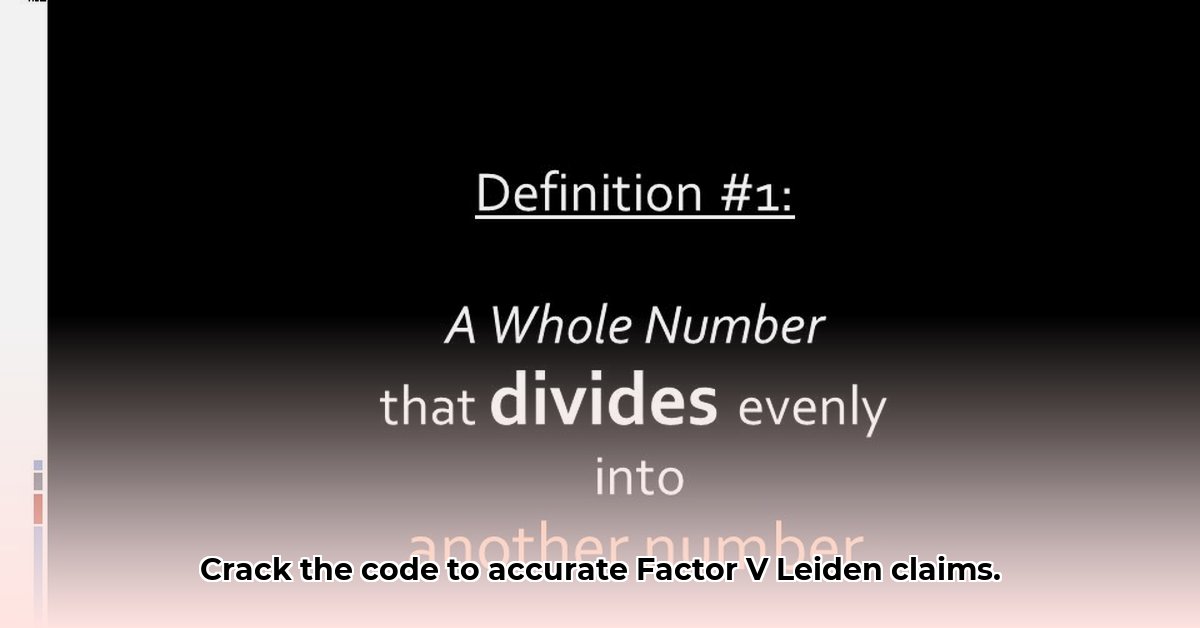Navigating the intricacies of medical coding is crucial for healthcare providers to ensure accurate claims submission and minimize denials. For inherited blood clotting disorders like Factor V Leiden, understanding the specific ICD-10 codes is paramount for efficient revenue cycle management and proper patient care. Understanding insurance coverage is also key; learn more about insurance coverage. This guide offers healthcare professionals and coders a detailed overview of Factor V Leiden ICD-10 coding, addressing common challenges, clarifying the D68.51 vs. D68.59 distinction, and providing a step-by-step approach to enhance coding accuracy.
The Challenge of Coding Factor V Leiden
One of the primary challenges in coding Factor V Leiden arises from the absence of a direct, specific ICD-10 code for this genetic mutation, which predisposes individuals to an increased risk of blood clots (thrombophilia). This absence necessitates the selection of the most appropriate code from a range of options, primarily D68.51 (Activated protein C resistance) and D68.59 (Other primary thrombophilia). This ambiguity can lead to inconsistencies in coding practices, potentially resulting in claim delays and rejections, impacting the financial health of healthcare organizations.
Decoding D68.51 vs. D68.59: A Guide to Accurate Diagnosis Coding
The key to differentiating between D68.51 and D68.59 lies in the level of detail provided in the physician’s documentation.
-
D68.51 (Activated protein C resistance): This code is appropriate only when the physician’s notes explicitly mention “activated protein C resistance” or a confirmed resistance to activated protein C. It signifies a documented impairment in the body’s blood clotting regulation mechanism due to Factor V Leiden.
-
D68.59 (Other primary thrombophilia): This code serves as a broader classification for various primary thrombophilic conditions that elevate the risk of blood clots. It is suitable when the physician’s documentation focuses on the overall increased risk of blood clots associated with Factor V Leiden, without specifically mentioning or confirming activated protein C resistance.
The selection of the correct code hinges on the specificity of the physician’s documentation. If the documentation explicitly confirms activated protein C resistance, D68.51 should be used. If the documentation focuses on the general increased risk of blood clots associated with Factor V Leiden, D68.59 may be more appropriate.
Best Practices for Accurate Factor V Leiden ICD-10 Coding
To minimize coding errors and improve claim accuracy, consider the following best practices:
- Comprehensive Medical Record Review: Conduct a thorough review of the patient’s complete medical record, including physician notes, lab results, genetic testing reports, and medical history, to obtain a comprehensive understanding of their condition and risk factors.
- Encourage Detailed Physician Documentation: Emphasize the importance of detailed and precise documentation by physicians, clearly articulating the diagnosis of Factor V Leiden, the presence or absence of activated protein C resistance, and the rationale for the chosen treatment plan. Accurate and specific documentation is crucial for accurate coding.
- Code Alignment with Diagnosis: Ensure that the selected ICD-10 code accurately reflects the patient’s diagnosis, clinical presentation, and the overall treatment approach. The code should be consistent with the physician’s assessment and documentation.
- Stay Updated on Coding Guidelines: Maintain a commitment to continuous learning and stay informed about the latest ICD-10 coding guidelines, updates, and best practices related to Factor V Leiden. Regular training and education sessions are essential for maintaining coding proficiency.
- Establish Internal Coding Guidelines: Develop internal coding guidelines specific to Factor V Leiden to ensure consistency in coding practices across your facility or organization. These guidelines should be based on official coding guidelines and reflect the specific needs of your patient population.
The Consequences of Inconsistent Coding
Inaccurate coding can have significant consequences, leading to incorrect claim submissions, delayed or rejected payments from insurance companies, and potential denials of coverage for necessary treatments. Beyond financial implications, inconsistent coding can also skew statistical data related to Factor V Leiden, hindering research efforts and limiting a comprehensive understanding of the condition.
The Future of Factor V Leiden ICD-10 Coding
Addressing the challenges in Factor V Leiden coding requires a collaborative effort among healthcare providers, coders, and insurance companies. This includes advocating for clearer coding guidelines, promoting standardized documentation practices, and fostering ongoing communication between physicians and coders. As research advances and our understanding of Factor V Leiden evolves, future coding guidelines may be refined to better reflect the nuances of the condition and improve coding accuracy.
Choosing Between D68.51 and D68.59: A Practical Guide
Selecting the right ICD-10 code for Factor V Leiden requires careful consideration of the clinical context and a thorough review of the patient’s medical record. The choice between D68.51 (Activated protein C resistance) and D68.59 (Other primary thrombophilia) depends on the presence or absence of documented activated protein C resistance and the overall clinical picture.
Key Considerations for Code Selection
- Review the Medical Record: Carefully examine the physician’s notes, lab results, and genetic testing reports to determine the patient’s Factor V Leiden status (heterozygous or homozygous) and the presence of any clinical evidence of increased thrombophilia (e.g., history of blood clots, pulmonary embolism, deep vein thrombosis).
- Assess Clinical Significance: Evaluate the clinical significance of the Factor V Leiden mutation. Does the patient exhibit clinically relevant signs or symptoms of thrombophilia? Base this assessment on clinical findings, not solely on genetic testing results.
- Consider Additional Risk Factors: Take into account any additional risk factors that may contribute to the patient’s overall thrombophilic risk, such as oral contraceptive use, smoking, obesity, pregnancy, or prolonged immobility.
- Document Rationale: Clearly document the rationale for your code selection in the patient’s medical record, providing supporting evidence from the medical record and clinical findings.
Step-by-Step Decision-Making Process
- Is Activated Protein C Resistance Documented? If the physician’s documentation explicitly mentions “activated protein C resistance” or confirms resistance to activated protein C, select D68.51.
- Is There Clinical Evidence of Thrombophilia? If activated protein C resistance is not documented, but the patient exhibits clinical evidence of thrombophilia (e.g., history of blood clots), D68.59 may be more appropriate.
- Consider Additional Risk Factors: Take into account any additional risk factors that may contribute to the patient’s overall thrombophilic risk.
- Select the Appropriate Code: Based on the information gathered, select the ICD-10 code that most accurately reflects the patient’s diagnosis and clinical presentation.
Factor V Leiden ICD-10 Coding During Pregnancy
Coding Factor V Leiden during pregnancy requires careful consideration of the unique challenges and risks associated with this condition in pregnant women. Pregnancy itself increases the risk of blood clots, and the presence of Factor V Leiden further elevates this risk, requiring close monitoring and management.
Coding Considerations During Pregnancy
- The coding professional should be aware that Factor V Leiden during pregnancy requires careful consideration of clinical presentation and patient risk for proper billing and patient care.
- Factor V Leiden increase the risk of blood clots during pregnancy, this is something medical professionals need to carefully manage.
- Many healthcare providers use D68.51 (Activated protein C resistance), reflecting the underlying mechanism of the condition. However, D68.59 (Other primary thrombophilia) is another option, particularly when clinical symptoms are absent or mild. The choice depends on the individual circumstances and the physician’s evaluation of the patient’s risk and should be used with discretion.
- The complexities increase when considering Factor V Leiden Deficiency ICD-10 Coding in Pregnancy. Pregnancy itself elevates the risk of thrombosis, complicating the assessment of Factor V Leiden’s contribution. Therefore, precise documentation of both the genetic mutation and its clinical significance is paramount.
Step-By-Step For Accurate Coding During Pregnancy
- Review the complete patient chart: Examine all relevant medical records, including genetic testing results and clinical findings.
- Assess the clinical presentation: Note the presence or absence of symptoms, previous thrombotic events, and the patient’s overall risk profile.
- Determine zygosity: Distinguish between homozygous and heterozygous Factor V Leiden. The latter generally presents a lower risk.
- Consult coding guidelines: Refer to official ICD-10 guidelines and current medical literature for guidance for thrombophilia.
- Document the rationale: Record the reasoning behind the chosen code in the patient’s chart.
Heterozygous vs. Homozygous Mutations
Understanding the distinction between heterozygous and homozygous Factor V Leiden mutations is important for accurate coding. While the primary code, D68.51, applies to both, the clinical presentation and risk profile may differ, influencing the overall coding strategy. The severity of this risk depends on whether you have one copy (heterozygous) or two copies (homozygous).
Coding By Mutation
- Heterozygous Factor V Leiden: One copy of the mutated gene is inherited from one parent.
- Homozygous Factor V Leiden: Two copies of the mutated gene are inherited, one from each parent. This is associated with a higher risk of blood clots.
- D68.51 can be used for both conditions.
- Bento Box Glass Offers Practical, Eco-Friendly Meal Storage - December 16, 2025
- The Best Bento Box Price For Your Perfect Packed Lunch - December 15, 2025
- Bento Box Shopping Tips for Smart and Stylish Lunch Prep - December 14, 2025










